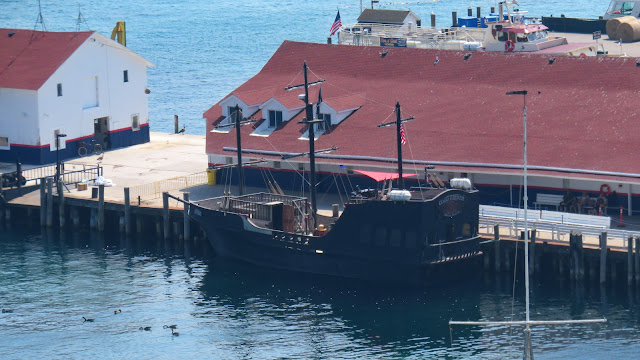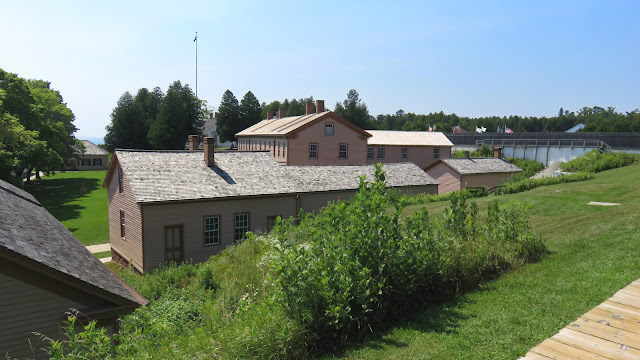Fort Mackinac
 |
| Fort Mackinac. |
After collectively devouring more fries than anyone should ever eat at the Chuckwagon, the four of us made our way to Fort Mackinac to explore Mackinac Island's military history.
Sinclair's Fortification
Set high atop a bluff overlooking Mackinac Island's harbor, Fort Mackinac has a commanding view of the southern approach to the island and the critical shipping route through the Straits of Mackinac. Entrance to the fort is via a long ramp angled diagonally across the bluff's face.
Historic Fort Mackinac traces its history back to 1779:
 |
| Sketch of Fort Mackinac as it looked in British hands in 1784. |
- 1779: British Lieutenant Governor Patrick Sinclair, recognizing that the wooden stockade fort of Michilimackinac on the south side of the Straits of Mackinac was poorly defensible, orders construction of a new fortification high on the Mackinac Island bluff in 1779. Fort Michilimackinac's armament is relocated to the new fort on the island. The fort is not completed before the American Revolution ends in 1783.
 |
| Sketch of Fort Mackinac circa 1800 after American occupation. |
- 1796: American troops take control of the neglected British fort, adding blockhouses to the defenses, completing some of the unfinished stone structures within, and altering the footprint of the fortification to generally reflect what we see today.
- 1812: British troops capture Fort Mackinac during one of the first engagements in the War of 1812.
- 1814: British troops holding Fort Mackinac repel an American offensive to retake the fort.
- 1815: American soldiers return to Fort Mackinac after the war.
- 1827-1828: American soldiers replace several of the aging fort buildings and add a new post hospital, a bakery, and a carpenter shop.
- 1858: The bakery catches fire, leading to the loss of several wooden buildings within the fort walls that must be rebuilt. A new bakery is constructed outside the wall.
- 1875: No longer considered a critical military facility, Fort Mackinac becomes headquarters of Mackinac National Park. In the decade that followed, additional buildings and conveniences (a bathhouse with running water!) are added, some of them outside the fort walls. The current fort reflects the layout it had between 1885 and 1889.
- 1895: The United States Army decommissions Fort Mackinac.
 |
| Sketch of Fort Mackinac as it looked circa 1885 near the end of its service life. |
Up the Ramp
 |
| Fort Mackinac |
From Fort Street, little is visible of the fort except for the west blockhouse (from 1799) and the long ramp leading across the bluff's face to the south entrance.
 |
| Alicia, Alyssa, and Tom at the top of the ramp leading into Fort Mackinac. |
From the top of the ramp, the view is impressive with the town of Mackinac Island and the harbor spread out at our feet.
The south face of the fort is protected by a thick limestone wall with a simple portal that allows entry.
The first thing I saw on entering the fort was a cannon pointed in the general direction of town.
Where's Captain Jack Sparrow? The Good Fortune is a Mackinac Island Ferry Company boat mocked up to look like a pirate ship. Like the other ferries, it also provides transportation between Mackinac Island and the mainland, though it does so more slowly and with greater emphasis on swashbuckling.
 |
| The historic city of Mackinac Island as seen from Fort Mackinac. |
"Where's the Kaboom? There's Supposed to be an Earth Shattering Kaboom!"
We arrived just in time to see a demonstration firing of this six pound gun. Considering that it was pointed right at the harbor, it is probably best that no actual cannon balls were involved.
Exploring the Fort of the Great Turtle
After the cannon demonstration, we made our way counter clockwise around the fort. Pictured here from left to right are the post commissary (roof only, from 1878), office (1858), quartermaster's storehouse (1860), and post bathhouse (1885). The larger two story building in the background is the 1859 soldier's barracks.
Upstairs in the east blockhouse, we found these smaller portable cannons set up to defend from tourist invaders coming at us from the Somewhere in Time Gazebo.
At the northeast corner of the fort, we could see the backside of the soldier's barracks (1859, center).
From the north blockhouse, we could see the stone officer's quarters (1780, left) and the post hospital (1828, right).
Tom and Alicia proceeding along the western stockade wall toward the west blockhouse (1799).
From the west blockhouse, we could see the Officer's Hill Quarters (1834, left) and the post hospital (1828, right). We spent some time in the Post Hospital and, frankly, the "medical" implements on display were terrifying. A soldier's best hope was to avoid getting sick or wounded. "Primitive" barely scratches the surface as a descriptor.
We toured the Officer's Hill Quarters (1834) that featured diary excerpts from past commanding officers of the fort describing the hardships of nineteenth century life at Mackinac. Clearly, the rear portion of the fort was not considered particularly at risk during that timeframe because the back half of the house was outside the fort's perimeter.
Hey! Wait a minute! Did I just see a golf cart on that fairway?!
The fort parade ground stands immediately before the soldier's barracks (1859, left).
Another shot of the west blockhouse built in 1799.
The stone officer's quarters (1780) was a structure that was started by the British and finished by American soldiers after the Revolutionary War. Having been started in 1780, it is often cited as the oldest building in the state of Michigan that is still standing. There are at least two other buildings on Mackinac Island that date to the same year.
It is interesting to me that the stone officer's quarters was built directly atop the fort's main rampart. The phrase "cannon fodder" comes to mind.
As for the officers who had to live in the wooden officer's quarters (1816) right next to it...well...it is probably a good thing that the fort never actually endured a full frontal assault. Here, Tom inspected a panel of the preserved original 1816 wooden siding.
Old window, new vista. Nineteenth century United States Army soldiers probably did not sip cocktails under gaily colored umbrellas back in the day.
Authentic panes of glass can be differentiated from modern ones because they transform images into impressionistic visions.
Sketchy Frontier Medical Ethics
As a Michigan native, I immediately recognized the name "William Beaumont" as namesake of a highly ranked hospital in metropolitan Detroit.
It turns out that Beaumont was the Army surgeon posted to Fort Mackinac on June 6, 1822 when young French Canadian voyageur Alexis St Martin was inadvertently shot at the American Fur Company's store on Market Street. Beaumont was fetched from the fort and, judging the wound to be mortal, had St Martin moved to the post hospital. Defying the odds, the young man survived and his wound healed as a fistula, leaving an opening directly into his stomach. Beaumont spent the next decade conducting hundreds of experiments on St Martin that led to significant learnings about the function of human digestion.
Though valuable, the conditions under which this knowledge was collected are questionable. Beaumont never attempted to close St Martin's wound, instead he seized on it as an opportunity for experimentation. In exchange for being Beaumont's lab rat, St Martin was given room and board and essentially worked as a servant for Beaumont's family. I think that modern day Human Resources would have an issue with that kind of power dynamic.
 |
| Photo by random dude. |
While Tom and I perched on the base of Beaumont's memorial, a random oldster spotted Alyssa and Alicia working on a selfie and offered to take a photo of them. They played along, but when they walked back toward me and Tom, the guy muttered something about, "Oh, you're with other people" and beat a hasty retreat. Had Stacey been around, a phrase involving the word "flypaper" would have undoubtedly been invoked.
 |
| Photo by Alyssa. |
A good pilot is always keenly aware of his surroundings. Hang on...what are all of you looking at?

We watched a rifle demonstration on the parade ground.

Next to the north entrance is the reading room (1879) that was arranged like a schoolhouse. There was definitely something a little off about that American flag flying outside the gate, however.

Next to the north entrance is the reading room (1879) that was arranged like a schoolhouse. There was definitely something a little off about that American flag flying outside the gate, however.
With only fifteen stars, United States flags like this one were only in use from 1795 to 1818. I assume that this one is not vintage.

Shown here are the quartermaster's storehouse (1860, left) and the office (1858, right).
The Trinity Episcopal Church dates back to 1882 and stands across Fort Street from the beginning of the ramp leading to Fort Mackinac.
A postcard view of Mackinac Island east of Fort Mackinac.

Shown here are the quartermaster's storehouse (1860, left) and the office (1858, right).
A Commanding View
In addition to representing a fascinating look into history, Fort Mackinac provides an outstanding view of the area.
This included views of the harbor and Mackinac Island's nearest neighbor, Round Island.
Off in the distance, my zoom lens was able to bring the 1895 Round Island Lighthouse into view from about 1 mile away. Even at a mere one mile distance, haze from wildfire smoke was apparent.
The Round Island Passage Lighthouse built in 1947 has far less personality than its counterpart on the south side of the Round Island Channel.
The Trinity Episcopal Church dates back to 1882 and stands across Fort Street from the beginning of the ramp leading to Fort Mackinac.
A battered freighter cruised through the Round Island Channel. Given our pristine, historical surroundings, the freighter looked a bit out of place.
Despite the haze of the day, the massive suspension bridge spanning the Straits of Mackinac can be seen from five miles away. Completed in 1957, the Mackinac Bridge is considered the longest suspension bridge between anchorages in the Western Hemisphere. All of those qualifiers mean that, yeah, it's really long, but others are longer.
 |
| Photo by Alyssa. |
Having explored most of what the fort had to offer, we departed through the south sally port and made our way back into town. It was time to "live in the now".


































No comments:
Post a Comment